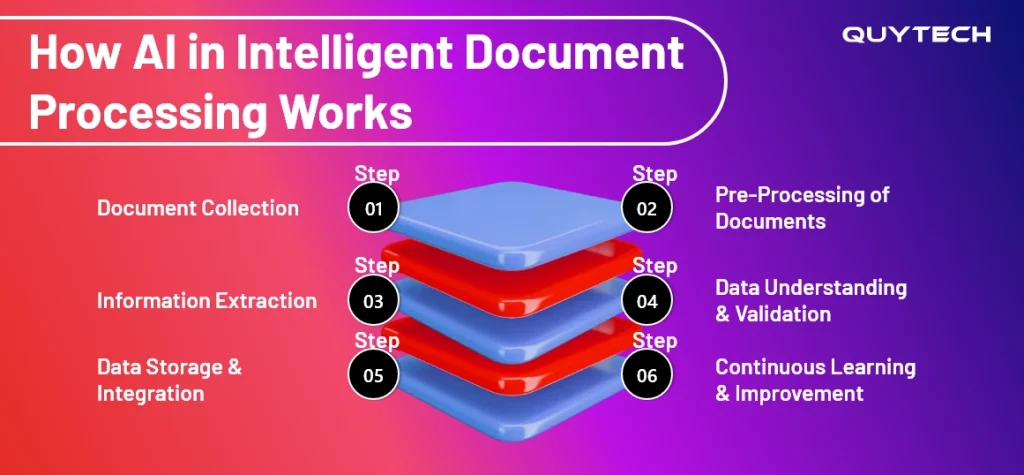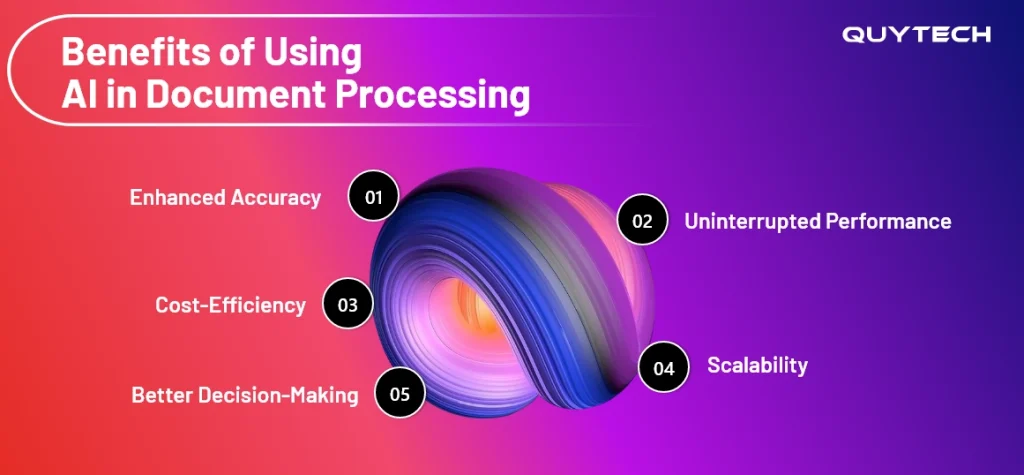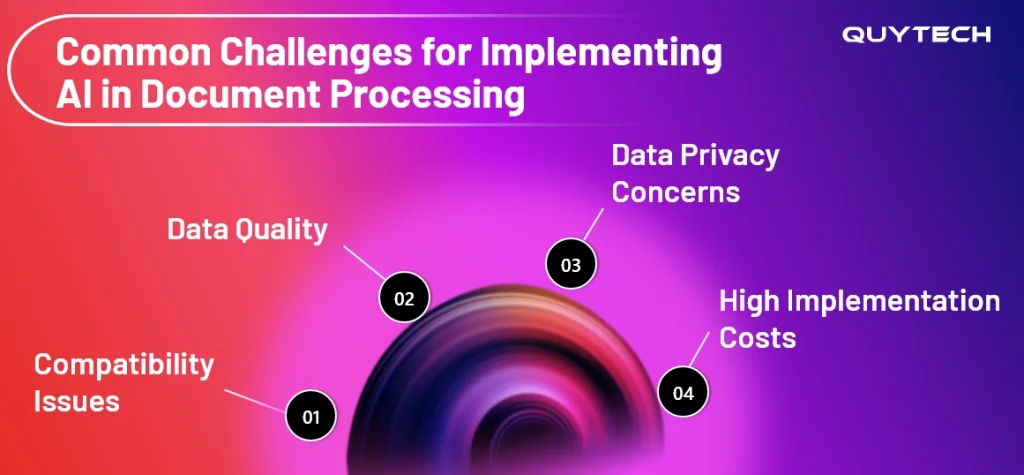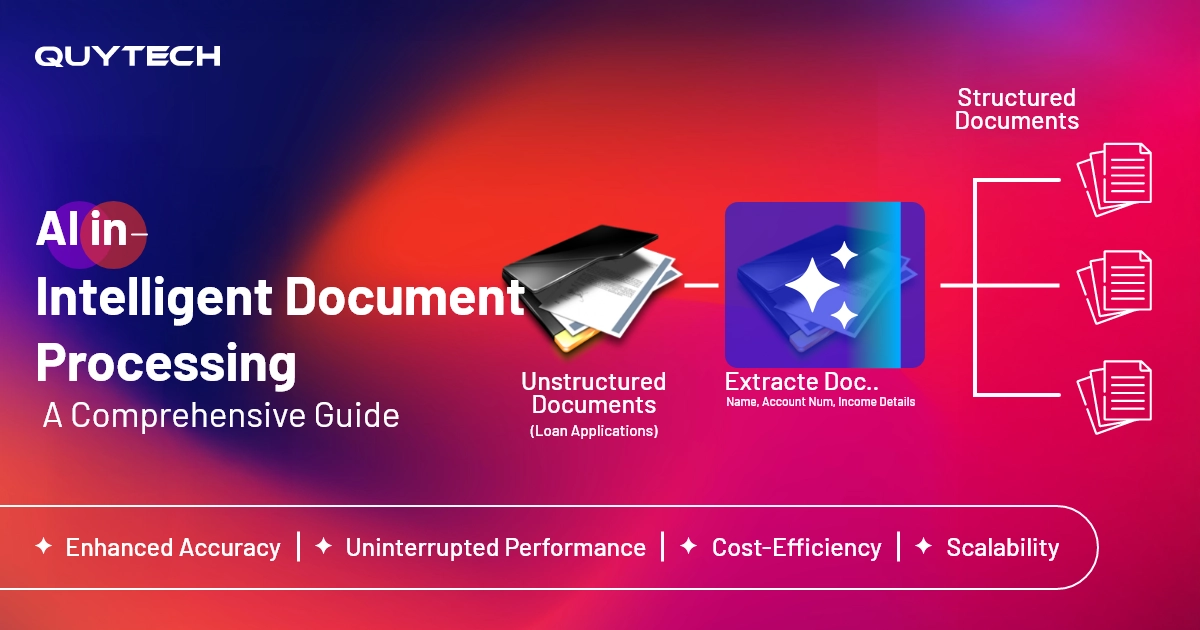Imagine working on urgent tasks and going through multiple stacks of documents manually. Sounds tiring. What’s more, the results may lack accuracy, as they’re prone to error. This challenge is not limited to urgent situations. Even when processing documents as a routine, accuracy often ends up getting compromised. And the main cause of these shortcomings is that they are operated manually.
This is where AI comes into play. It gives the outdated process of document processing a makeover, turning it into an intelligent one. AI in intelligent document processing introduces accuracy, adaptability, speed, and consistency. And how does AI bring so much to document processing?
If that’s what you’re curious about, then you’re at the right place. This blog covers everything from the role of AI in intelligent document processing to the best practices for implementation.
Key Takeaways:
- AI in IDP automates manual document processing, improves speed, accuracy, and insights.
- Its working mechanism involves collecting, cleaning, extracting, validating, and learning from documents.
- IDP’s features include automated data extraction, contextual understanding, and workflow automation.
- Enhanced accuracy, decision-making, and scalability are some benefits of IDP.
- Compatibility, data quality & privacy, and implementation costs are some implementation issues.
The Role of AI in Intelligent Document Processing
In traditional document processing, the whole procedure is carried out manually. The process can be defined as a person or group of people reading all the documents, extracting information, and entering it wherever required. The lack of accuracy and time-consuming nature make this process outdated. The costs of maintaining a workforce and limited scalability also add to its inefficiency.
The role of AI in intelligent document processing is to bring in technological advancements to carry out the tedious tasks with precision and speed. To make this possible, AI uses optical character recognition, computer vision, NLP, and ML.
How AI in Intelligent Document Processing Works
Understanding intelligent document processing just by knowing the role it plays is not enough. To enhance your understanding of IDP, we have created this step-by-step working mechanism of AI in document processing:

Step 1: Document Collection
The first and foremost step includes collecting documents. Sources, like invoices, PDF files, Word documents, emails, images, etc., facilitate this step. The system collects all relevant documents and stores them for processing.
Step 2: Pre-Processing of Documents
Since the documents collected are in different formats and types, preprocessing is done. It removes noise, cleans the documents, and enhances quality for easy processing. This step adds speed and accuracy in intelligent document processing.
Step 3: Information Extraction
Once the documents are cleaned, processing takes place. It is the core step where AI starts analyzing these documents. Optical character recognition, natural language processing, and computer vision are utilized in this step.
Step 4: Data Understanding & Validation
After the data is processed, AI works on understanding the information that the document reflects. It grasps the context of every document. It also detects anomalies, mismatches, and performs validation.
Step 5: Data Storage and Integration
Once the data is validated, it is stored and integrated into the system. This step is carried out by robotic process automation. It reflects the processed documents and data into the system automatically.
Step 6: Continuous Learning & Improvement
The working mechanism of the intelligent document processing system does not end at data integration. It makes use of machine learning algorithms to continuously learn and improve its performance with every output it delivers.
Key Capabilities of AI in Intelligent Document Processing
What truly makes technological advancements stand out are the features that they offer. AI in intelligent document processing stands out with its automation, analytics, insight generation, and language support features. Here’s a detailed list of the features of AI in intelligent document processing:
Automated Data Extraction
An intelligent data processing system is capable of automating the process of data extraction. AI does not depend on human intervention to extract data and clean it. AI makes use of optical character recognition to read texts from documents. For visual information, it makes use of computer vision. And to interpret meaning from data, natural language processing is used.
Contextual Understanding
AI in intelligent data processing is capable of deriving contextual meaning from the documents. With the help of natural language processing and semantic analysis models, AI makes sense of the data extracted. AI in intelligent data processing is capable of understanding the correlations of data points, contributing to enhanced accuracy.
Workflow Automation
Intelligent document processing can automate workflows. It utilizes robotic process automation to automate repetitive tasks, eliminating the need for human intervention. IDPs are capable of integrating with existing systems. This allows them to automatically update data into these systems as soon as it is processed.
AI-Powered Analytics
AI in intelligent document processing goes beyond basic meaning extraction. Apart from storing and integrating the data acquired from documents, it offers insights as well. AI does so by utilizing data visualization and analytics tools. These tools analyze the processed data, connect the dots, and provide insightful recommendations.
Multi-Format & Language Support
IDPs are capable of analyzing documents of different formats and languages. These systems are not limited to analyzing just a specific type of document. They can process everything from images and JPEGs to PDFs and invoices. Along with this, intelligent document processing can also process documents written in different languages.
You Might Also Like: AI in Cyber Threat Prediction and Defense: Strengthening Cybersecurity
Benefits of Using AI in Document Processing
Now you’re aware of the features that AI in intelligent document processing offers. But how do these features come out as an advantage to businesses using intelligent document processing? Here’s how:

Enhanced Accuracy
AI in intelligent document processing enhances the accuracy of the whole procedure. Its functioning is powered by artificial intelligence. This means that there is very minimal human intervention, which automatically eliminates the chances of human error.
Uninterrupted Performance
As already mentioned, intelligent document processing works automatically with minimal human intervention. This makes it capable of performing continuously without getting tired of taking breaks.
Cost-Efficiency
AI in intelligent document processing introduces cost-efficiency in document processing. It eliminates the need for allocating multiple people to handle different tasks. Instead, it automates these tasks, allocating the human workforce to higher-level tasks, saving costs in the long run.
Scalability
IDPs offer high scalability to businesses. Being powered with artificial intelligence, intelligent document processing systems can easily handle large amounts of documents for processing. They do not require additional human resources to function on a large scale.
Better Decision-Making
AI-powered intelligent document processing helps in completing tasks that otherwise take weeks to complete within seconds and minutes. This helps the management acquire data for quick and informed decision-making.
Similar Read: AI in Customer Journey Mapping: Insights and Impact
Industry-Wise Applications of AI in Intelligent Document Processing
Now that you are aware of the benefits that AI in intelligent document processing introduces, let’s take a look at its applications across different industry verticals:
Healthcare
- In the healthcare sector, AI in intelligent document processing helps in managing patient data.
- Healthcare institutions use IDP to extract patient details from structured and visual data.
- IDP also assists in assessing patient data for validating insurance claims.
Human Resource
- In human resource management, AI-powered IDP helps in processing candidate data through resumes for screening and selection processes.
- It helps in automating data extraction from employee documents during the onboarding stage.
- Intelligent document processing also assists in maintaining employee attendance, performance, and related records.
Legal
- AI-powered intelligent document processing helps in analyzing contractual documents in the legal field.
- Based on the context and type of data, IDP organizes documents like court filings, case files, etc.
Finance
- In finance, AI-powered intelligent document processing carries out the tasks of extracting transaction data from bills and invoices.
- It assists in processing loan applications by analyzing documents submitted to validate or reject based on the criteria.
Logistics
- In logistics, intelligent document processing works on extracting transactional and numerical data from shipment invoices.
- It helps in accurately and efficiently processing the customs-related documents related to the import and export of goods.
- IDP assists in maintaining organized records of documents involved during the movement of goods.
Read More: AI in Employee Performance Analysis and Skill Development
Common Challenges and Best Practices for Implementing AI in Document Processing
Implementing AI-powered intelligent document processing brings in greater efficiency. But like any other technology, it also has its fair share of challenges. Here are some of the common challenges, along with the best practices for implementing AI in document processing:

Compatibility Issues
Many organizations may face the challenge of implementing intelligent document processing in their existing systems. This arises due to outdated systems, which are often not capable of supporting sophisticated systems.
Best Practices to Overcome Compatibility Issues
In case of outdated or incompatible systems, businesses can opt for APIs to integrate intelligent document processing systems into their existing ones.
Data Quality
Another common implementation challenge faced by organizations is the poor quality of data. This usually arises due to unclear and unstructured documents. Analyzing these documents leads to inaccurate outcomes.
Best Practices to Overcome Data Quality Challenges
To ensure that document quality does not impact your outcomes, businesses should utilize image processing tools. These will assist in enhancing the quality of the documents for better processing outcomes.
Data Privacy Concerns
Different organizations utilize different kinds of documents to derive information. These documents might contain confidential and sensitive information. In such cases, data privacy concerns may arise.
Best Practices to Overcome Data Privacy Concerns
To ensure that businesses rely on intelligent document processing without any worries, it is important to integrate data protection practices. These include data encryption, activity tracking and logs, authorization, etc.
High Implementation Costs
Being powered by AI-powered technologies, implementing IDP can be a costly solution. Implementing AI in intelligent document processing often requires investing in sophisticated systems. This often results in organizations being hesitant about implementing it.
Best Practices to Overcome Implementation Cost Challenges
Businesses considering implementation costs as a challenge can opt for pre-built and trained intelligent document processing solutions. Another solution could be opting for cloud-based systems, which would bring in easy accessibility and lower implementation costs.
You Might Also Like: AI in Customer Service 101: Use Cases, Benefits, Challenges, Implementation Process, and More
Future Trends of AI in Intelligent Document Processing
AI in intelligent document processing is not just a current-day trend; it’s a step towards the future. And like any other technology, it will also evolve to meet the demands of the future. Here are some future trends of AI in intelligent document processing:
Enhanced Processing with Gen AI
The future holds the integration of Generative AI in intelligent document processing. With generative AI, document processing will not just extract data from documents, but will also extract meaning from it. Intelligent document processing would become capable of understanding the document, predicting future outcomes, and even suggesting action plans.
Multimodal Document Processing
In the future, Intelligent document processing will become capable of understanding much more than just texts from documents. It will be able to extract data from tables, charts, annotations, and even audio files. IDP will be able to derive data from various sources at the same time.
Real-Time Document Intelligence
The future holds real-time document intelligence for IDP. AI in intelligent document processing will be capable of processing documents as soon as they are received. This will make intelligent document processing even more efficient than it is at present.
Adaptive Models
Intelligent document processing will become capable of understanding its users’ usage habits and feedback. This will result in IDP becoming more adaptive and induce continuous learning for enhanced performance.
Conclusion
AI in intelligent document processing is much more than a fancy technological advancement. It’s a step towards enhanced productivity without compromising the quality of the outcomes. What truly makes AI in intelligent document processing shine is the benefits that it introduces in the document processing field.
IDP brings in enhanced accuracy, uninterrupted performance, cost efficiency, scalability, and improved decision-making. IDP serves multiple industries, from healthcare to logistics. Its adaptability and future growth make it a worthwhile investment.
FAQs
Traditional OCR just converts the documents into machine-readable text. Intelligent document processing does more than just convert the text. It understands it, extracts meaning, and also classifies the data extracted.
Yes, intelligent document processing can handle both handwritten and multilingual documents. It makes use of advanced OCR and AI models to process these documents.
Yes, intelligent document processing is not just suitable but also very beneficial for small and mid-sized businesses, as they can opt for cloud-based, affordable solutions.
Yes, you can implement an AI-powered IDP in your business without a technical team by either partnering with an AI solution development company or by hiring developers.



